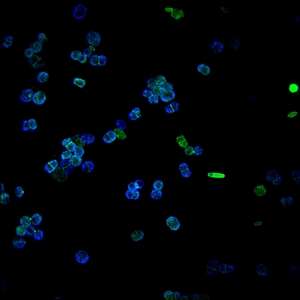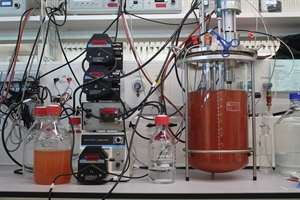Researchers confirm cell wall of anammox bacteria contains the structural molecule peptidoglycan

Contrary to what you will read in textbooks, the cell wall of anammox bacteria contains the structural molecule peptidoglycan after all. This is the conclusion of a group of microbiologists from Radboud University, Umeå University (Sweden) and Indiana University (the US) in an article in Nature Communications, published on May 12.
Ever since their discovery, anammox bacteria continued to surprise scientists. First of all these bacteria can oxidize ammonium anaerobically. They also have a unique cell structure: anammox bacteria have three cell compartments, which make them similar to cells with a nucleus (eukaryote), while anammox does not have a cell nucleus (prokaryote).
Dogma ended
It now appears that the cell wall of anammox bacteria is very different from what has generally been assumed for many years. Every textbook states that the cell wall of anammox bacteria does not contain peptidoglycan – a sugar-protein chain that strengthens the cells of most bacteria. Microbiologist Muriel van Teeseling and colleagues at Radboud University wanted to find out what provided the anammox cell with its stability and investigated the cell wall of the bacteria using powerful cryo-electron microscopes and a highly sensitive method to discover the exact structure of peptidoglycan (Figure 1). They discovered that anammox bacteria do in fact contain peptidoglycan, ending a dogma in microbiology.

No exception after all
Van Teeseling: "This is an unusual discovery because we have looked for peptidoglycan in anammox for a long time. Still, we could not find the structure using our microscopes and we found no indication in the genome that it was there. However, now we have found it using cryo-electron microscopy and the incorporation of recently-developed fluorescent amino acids in the peptidoglycan layer." It therefore seems that in this sense, anammox bacteria are no exception after all.
Microbiologist Christian Jogler of the Leibniz Institute DSMZ in Germany discovered the same results in relatives of anammox bacteria and has also published his results today in Nature Communications. "These two independent investigations make the case against this longstanding dogma especially convincing," says van Teeseling.
More information: Anammox Planctomycetes have a peptidoglycan cell wall, Nature Communications 6, Article number: 6878 DOI: 10.1038/ncomms7878
Journal information: Nature Communications
Provided by Radboud University

















